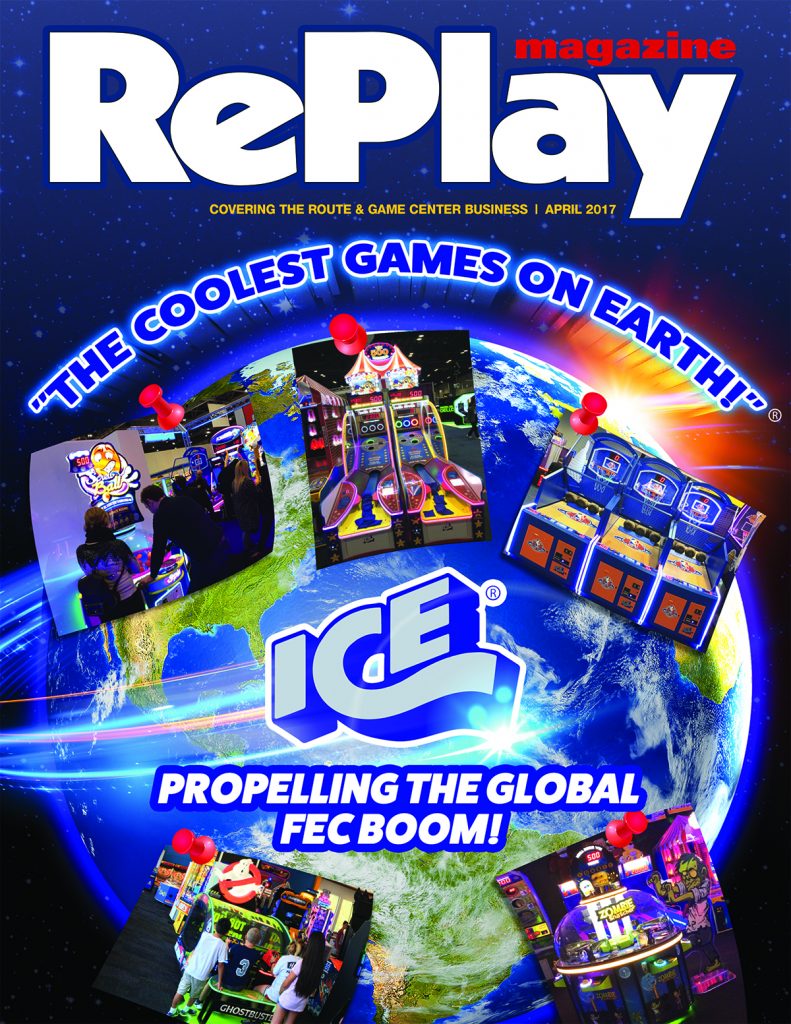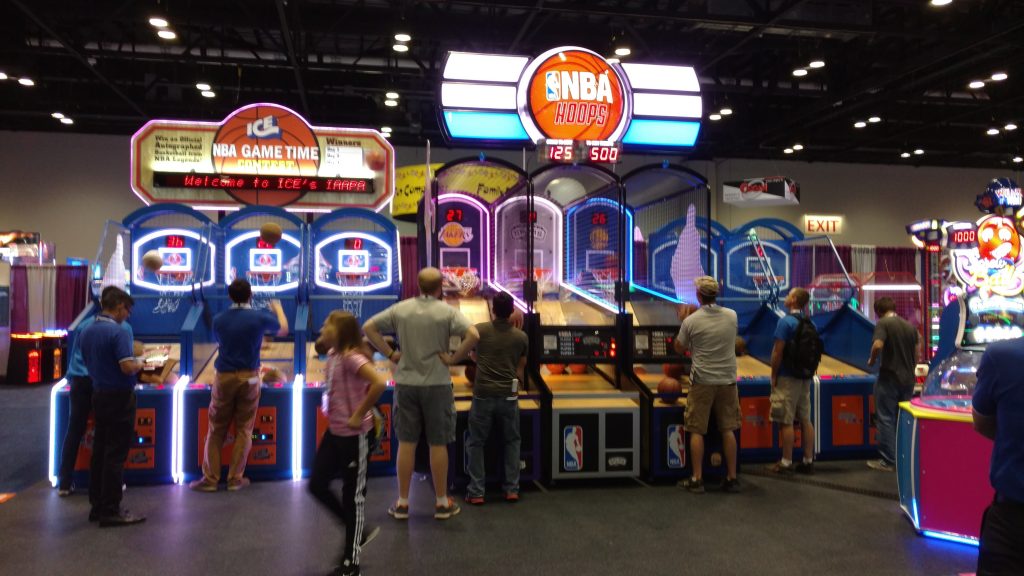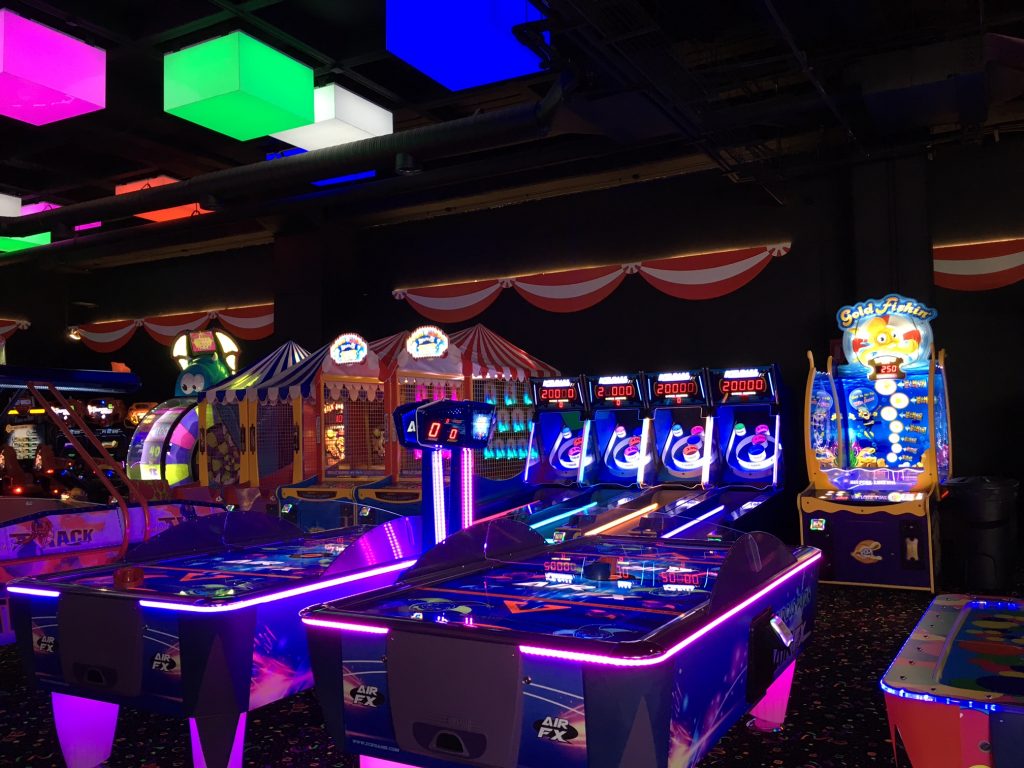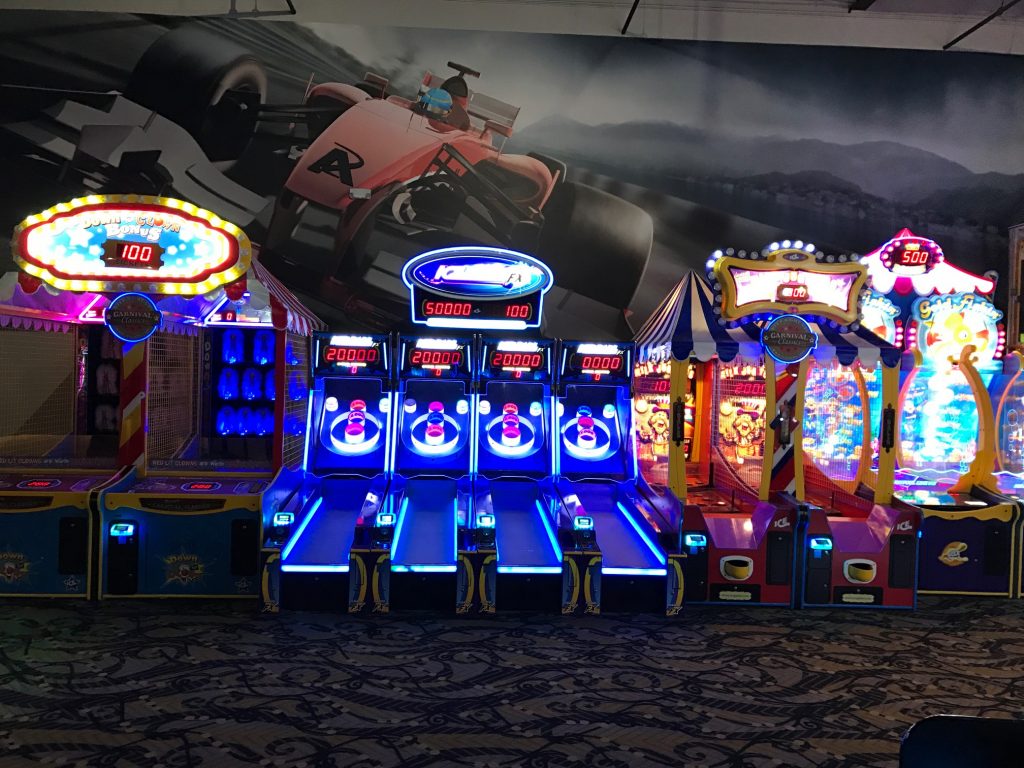 ICE-ing the FEC Boom Cake
ICE-ing the FEC Boom Cake
Bold Beliefs Keep ICE Globally Focused While Deeply Rooted in the U.S.
It’s a bullish time in the FEC world! While the number of individual companies owning fun centers has remained relatively constant, the actual number of locations has increased significantly. (Estimates are that there are now some 8,000 FECs worldwide.) Globally, the boom can be attributed to the usual economic factors such as favorable oil prices, stable local economies, low interest rates and increases in consumer spending, as well as the evolution of how and where people are consuming their meals.
Buffalo, N.Y.-based game maker ICE (Incredible Concepts in Entertainment) has been bullish on fun center product for decades, their own growth paralleling that global trend at a level execs proudly describe as “remarkable.”
Founded in 1982 with the creation of Super Chexx hockey, the manufacturer maintained a relatively small, yet active, portfolio of approximately 15 products from the ’90s to late 2000s. While some other coin-op companies and sectors were reeling from the devastating effects of the financial and housing crises of 2008 and 2009, ICE made a significant investment in itself and its future.
On the equipment side, the factory added a lengthy list of advanced manufacturing equipment. They increased the number of CNC equipment from two to six, bought a new laser machine, added a Schleuniger harnessing machine, and bought an SMT machine enabling ICE to manufacture its own circuit boards.
They also bullishly expanded the square footage of the production floor, added off site storage, increased its staff and invested in training so employees could continue the “one stop shop” mentality which ICE prides itself on. True to the company’s roots, to this day all aspects of its product line –– from concept to creation –– take place in Buffalo.
“Our commitment to Buffalo reaches further than maintaining our manufacturing facility here that employs over 250 people,” ICE Sales VP Joe Coppola said. “We pride ourselves on relationships with local vendors and suppliers that have been a vital part of ICE’s success the past 35 years. While in many industries, including our own, manufacturing is being relocated, we have continued to invest in our infrastructure here in Western New York and will continue to do so.
“We have a very strong commitment to making all of our products at our Buffalo facility, which allows us to maintain and monitor quality, while also being able to properly provide service to our customers in the years to come,” Joe continued. “We still provide parts and service support for Super Chexx games that were sold in the mid ’80s! That should speak volumes about our level of commitment to after sales service.”

In-House Design & Collaboration
While ICE was expanding its manufacturing capabilities, they also looked to do the same with game design. Still happy with what its own team was able to create and build, they also sought ideas elsewhere. ICE renewed its focus on increasing partnerships with leading software and concept designers in the amusement industry. In 2007, the company released Deal or No Deal with Play Mechanix, which they say cemented their position as a video redemption powerhouse by being able to eventually sell over 5,000 units at a time when they said many outsiders felt the arcade business was dying.
Deal or No Deal broke a few barriers in the industry on top of selling well, company execs asserted. Considered a “play value” game that took well over one minute per round, ICE said many believed the game couldn’t earn enough money per play. Instead, the game’s success proved operators could charge more than normal and players would continue to pay and “play all day long.” According to ICE, this gave arcade owners and operators confidence that they could get creative with the various game play options available. This concept of charging more per play was carried over to other games as well.
ICE said this continued reinvestment and success with Deal or No Deal allowed for an increase in infrastructure in its R&D department, which is headed by Drew Krouse.
“ICE realized early on that the market was yearning for quality and reliable product, but also offerings that were balanced and not just one type or style,” Krouse said. “We ensure, year in and year out, that we’re always developing a mix of the top video redemption and electromechanical games that touch on all bases and appeal to the widest market possible.”
Krouse also pointed out that ICE is working with and seeking out some of the top licenses in the world. From Ghostbusters to the Pink Panther and Angry Birds, ICE games are outfitted with highly recognizable licenses torn from the zeitgeist of the U.S. today. As ICE’s profile and product line has grown, Krouse said major accounts have begun coming to the company with custom development ideas, expanding the company’s capabilities exponentially.
Focus on Testing & Feedback
Toppers at ICE recognized that to maintain the success of their game lineup they had to carefully plan, organize and analyze. Four years ago they completely revamped their in-house game testing procedures. Mike Tobin, who leads ICE’s marketing department, also leads the new game testing program, acting as the critical liaison between R&D and locations worldwide.
This process, he said, has helped ICE implement invaluable feedback from players and game service technicians throughout the world, using that input to fine tune the final version of the product that will be released to market.
Since its inception, ICE has produced a nice number of successful titles that continue to bring strong earnings to FECs throughout the global marketplace. The diversification of ICE’s portfolio –– from the Carnival Series, many electromechanical skill games, licensed video redemption titles and continued updates to traditional games like IceBall, NBA Game Time, Air FX and the Grab N Win crane –– illustrates the “never be satisfied” mentality of the management team at ICE, said Tobin.
Execs at ICE also recognized that while brand new product introductions were important, they also needed to continue to push themselves to improve existing staple products for its growing customer base. An alley roller, basketball game or crane that was cutting edge 15 or 20 years ago needs new technology and new “wow” factors to draw players in.
Luckily for both sides of the equation, as ICE was investing in diversifying its product line, operators worldwide started to became more willing to invest in their facilities, adding attractions, enlarging game room space, expanding redemption counters and increasing staff.
FECs on the Rise
As the economy slowly improved (from 2010 to 2016, the world GDP hovered around 2.5 percent growth according to worldbank.org), the FEC sector saw companies like Dave & Buster’s growing from just over $500 million in revenue in 2010, to close to $900 million as of January 2016. With the trademarking of “Eat, Drink, Play, and Watch Sports®” by Dave & Buster’s, ICE says the industry and outsiders both took notice of the relatively new concept of providing an all-inclusive experience under one roof.
Tobin said, “Dimly lit rooms with quarter and token dispensers may have served the pixel-hungry arcade crowd of the past, but now were replaced with hip bars, bright lights, diverse food menu, and automated payment systems that significantly increased the average spend per customer, while also speeding up their average transaction time.
“It’s been reported by various industry experts and studies,” he continued, “that automated payment and swipe card systems increase the average spend by roughly 30%! Now with the average spend per customer increasing, while simultaneously spending more time under one roof, FECs saw an influx of attendance and revenue that was unprecedented since the golden ages of Pac-Man in the 1980s.”
Dan Coppola (U.S. sales) provided his perspective on the resurgence of the FEC concept: “Out of home entertainment will never go away. The FEC boom is tied to the overall experience that customers are enjoying under one roof. The interaction, excitement and reward of playing a redemption game is hard to replicate. ICE spends months, sometimes years, developing and testing these gameplay experiences. People can’t do this at home on a game console, like being able to rock climb, while the family rides go karts or plays laser tag,” said Dan.
“What we’re really seeing is the investment from locations that recognize that more available activities gives the customers more reasons to stay at the FEC longer. Games are becoming more and more of a key part of that,” Dan continued. He added that ICE’s lineup of games are engaging and let people interact and socialize while playing together, definitely complimenting the current direction of the industry.
“There is no doubt many people in the coin-op industry were at one time both concerned and scaling back due to the rise of all the home entertainment platforms, computer gaming and the expansion of the mobile phone market,” Dan said. “But we’ve since learned that people and families still yearn for the socialization and human interaction that the FEC market provides.”

Global Reach
With the increase in FEC attendance paired with a renewed focus on expansion within the U.S. hitting its stride, ICE’s Director of International Sales Gene Brogowski says the global markets have started to ramp up, too. He’s been busy consulting in new markets that have no previous experience with “modern redemption,” let alone large scale FECs. Brogowski, with his 25 years of amusement expertise, works with customers throughout their entire project, alongside architects and construction managers to ensure the game selection and redemption experience receive the necessary attention.
“The critical component to success on our customer’s projects has been spending time on the ground and personally visiting their sites during the development stages,” said Brogowski. “We get involved at the inception of the project and are there after it opens. It never gets old, and only becomes more rewarding as more successful projects flourish.” (Brogowski was excited to share that ICE worked with Dreamland, a FEC in El Salvador, from concept to opening, and the new facility went on to win IAAPA’s best FEC award last year.)
ICE has worked directly in the Middle East and other developing countries for over 24 years exposing the markets to the modern FEC experience those in the U.S. had grown accustomed to. ICE was the first on the ground in many countries, Brogowski said, developing the first FEC in Kazakhstan (working with Hoppylon on their flagship FEC at the Mega Mall), helping with the Crazy Park FEC project alongside Unicum in Russia, and aiding early locations in the still young and developing FEC market in India.
Brogowski said: “I’ve been committed to the amusement industry for almost half of my life and have prided myself on consulting on some of the most successful FECs in the world. I’ve watched my friends at LAI Timezone, Landmark- Fun City, Al-Hokair, Al-Othaim, and many other valuable partners throughout the world grow and flourish in this tremendous industry.”
While working directly with customers in many countries, ICE uses its distributing partner Sega Amusements International in Europe, Turkey and Russia. The two companies have invested significant resources to continue developing markets that had bought into the redemption concept early, and now see significant growth and expansion as redemption becomes more popular in FECs.
“Sega is a prime example of a committed and dedicated sales team, led by their general manager Justin Burke,” Brogowski said. “They have great, well-seasoned sales representatives, who are dedicated to the further development of the redemption concept. We work with them cooperatively, each and every day.”
About that relationship, said Joe Coppola: “The Sega team is to us an expansion of the ICE family in Europe. We can’t say enough about their sales reps –– Martin, Maria, Steve and Darrell. Their service team led by Jay is fantastic. Justin Burke leads the charge with this group and his commitment, focus and, at the same time, genuine friendship has really made the relationship rewarding at every level. And finally, we have the utmost respect for Paul Williams. He has assembled a really nice team and truly runs his business aligned with the same principles and ethics that have always been important to my father, Ralph, making Sega a natural European partner for ICE.”

Strong Stateside
U.S. salesman (and 25-year industry vet) Greg Kania added, “The amusement and FEC industry is riding a wave that we haven’t experienced in many years. The growth can be attributed to lots of great new product, but also from the continued education on behalf of both distributors and manufacturers. There is a lot of time spent on attending conferences and trade shows outside the typical FEC market in hopes of convincing many of these markets that the amusement and FEC industry is still an extremely profitable business if done under the proper guidance.
“What we are currently seeing leads me to believe that our message and education is starting to make an impact,” Kania continued. “We continue to see expansion in the bowling, skating rink, laser tag and trampoline segments that has been years in the making. Many of these centers are incorporating new budgets and committing new dollars to game rooms along with several major attractions that offer their guests lots to do and even more diversified activities. The days of providing the guest one form of entertainment, whether that be bowling, games or rides are long gone. Today, it’s becoming ‘bigger is better’ and it’s extremely evident that those locations doing it right are setting themselves up to ride that wave for many years to come!”
Such long-term success has many factors, but in conclusion, Coppola had one very important point to make clear: The quality of ICE’s games, the company’s successful global expansion and the many fantastic markets the company finds itself in would not be possible without good, hard-working people.
“The real reason behind any of the successes we have had in the past 30+ years come down to our people and their dedication and hard work,” Joe continued. “Our creative development team is, without a doubt, an incredibly focused group of people. Our production team is unparalleled. What these guys do, building 18 to 20 different product lines per week out of a stable of 35 different products, I honestly can’t think of another company in Buffalo that I can compare to.”
“Of course, I can’t say enough about sales and marketing group. Greg, Gene, and Dan are in many respects the face of the company and their ‘work in trenches’ week in and week out is something I am truly proud of. Not to mention the support they receive from Rebecca Hirsch and Mike Tobin. There are many days I would honestly say Rebecca is, in many respects, ‘running ICE’ and Mike is the consummate team player who juggles about 15 different titles and responsibilities and always with a smile. Combine them with our purchasing, shipping, accounting, parts and service staff, and I could go on for days about our people and their tremendous loyalty and effort.”
Joe closed by sharing one last-but-not-least bit: “None of us would even be here to discuss this vibrant FEC market and all these great opportunities without the leadership and driven focus of my father, Ralph. He’s led this ship for over 30 years and continues to lead it. He’s steered us through very tough times right through to these past years of growth and success.
“He has taught us to pay as much attention to the small details as the big picture stuff,” Joe continued. “Most importantly, at the end of the day, our reputation is all we have. We must make great product and a profit in a respectful and considerate manner. We’ll also make great friends and develop meaningful relationships along the way. There is no doubt in my mind, if each of us wakes up every day with as much passion and zest as my father has had for all these years, life will be good!”
Visit ICE online at www.icegame.com.

